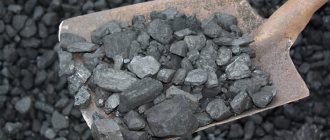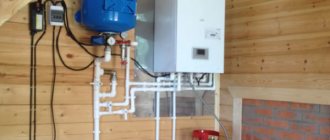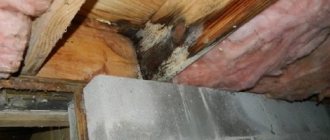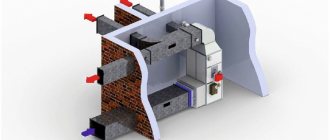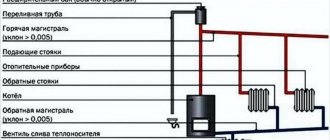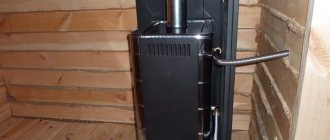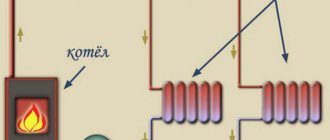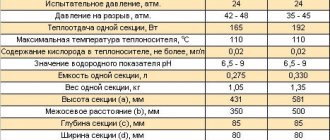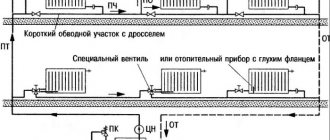Home / Gas boilers
Back
Published: 01/15/2020
Reading time: 4 min
0
2860
A gas boiler is a heat source for heating systems. This device is designed to convert the energy obtained from gas combustion into heat to heat the water coolant of the heating system.
The design of a gas boiler ensures the implementation of the main task - the efficiency and reliability of autonomous heat supply systems, with minimal participation from the user.
- 1 How gas boilers work 1.1 Double-circuit boiler
- 1.2 Gas burner design for the boiler
- 2.1 How a condensing boiler works
How gas boilers work
Main components of a gas boiler
The schematic diagram of a gas heating boiler is almost identical for most modifications. This means that the main blocks from which the boilers are assembled and the operating principle of a gas heating boiler are the same:
- The gas burner device is made in the form of a perforated rectangular structure. Inside which the nozzle is located. Gas fuel is supplied through it for combustion in the combustion chamber. Combustion efficiency is ensured by uniform distribution of fuel over the entire combustion surface.
- The heat exchanger is a steel box with a developed tubular heating surface. When gas burns, the heat released heats the walls of the heat exchanger, along the internal circuit of which the heating coolant flows. From contact with hot surfaces, the boiler heats the water, which later gives off its heat in the heating system. Single-circuit boilers have one heat exchanger for the heating circuit. In a dual-circuit system there are two, including a DHW heat exchanger.
- The circulation pump serves to force the movement of heating water in the heating circuit. The device is present only in boiler models with forced circulation.
- The expansion tank is a protective device that discharges excess coolant that is formed during heating of the heating circuit.
- Chimneys and components. Requirements for chimneys for gas boilers are determined by SNIP rules. In open-type atmospheric boilers, they are connected to chimneys operating with natural draft.
In closed fireboxes, the smoke exhaust is carried out through a coaxial pipe. Flue gases move through the central part of the pipe, and along the ring-shaped section, with the help of forced ventilation, air from the atmosphere is pumped into the firebox.
The presence of auxiliary components in the boiler distinguishes it from a gas water heater. The design of a floor-standing gas boiler differs from a wall-mounted one, with more powerful dimensions and weight, due to the fact that their design usually includes a storage tank for hot water.
The automatic control and protection unit is designed to regulate boiler modes depending on the internal/external air temperature and unit protection in case of emergency situations.
For example, high gas or coolant pressure, separation of a gas torch, water leakage, high temperature of the heating circuit or hot water supply. Its operation is based on the use of primary sensors - a gas boiler thermocouple and the operation of a three-way valve.
Double-circuit boiler
A double-circuit gas unit differs from a single-circuit boiler in that its design contains not one heat exchanger for heating, but two - primary and secondary.
Operating principle of a double-circuit boiler
The first is located directly in the gas combustion zone. Its purpose is to heat the heating fluid. The secondary one does the job of heating hot water.
It must be noted that a double-circuit gas boiler cannot operate synchronously in 2 modes. This explains the presence in its system of a three-way valve, which, when the hot water tap on the mixer is opened, sends the coolant into the DHW circuit.
Gas burner device for a boiler
The burner device of a gas boiler unit is classified into the following types:
- Single-level, capable of operating only in two options - Stop/Start. Despite their low profitability and reduced service life, they are popular due to their simple design and low price.
- Two-level, ensures the boiler operates in two modes - 50/100%. Its advantages are felt during the transitional heating period, since there is no need to use the device at full power to heat the home.
- Modulated - a smart system for adjusting the boiler unit modes, which is capable of independently adjusting the operation in the range of 20-100%. This system ensures efficient and long-lasting operation of the boiler. Moreover, its price is an order of magnitude higher than conventional heating analogues with one and two-level burner devices.
In addition, burners are divided into open and closed type installations. In the first option, the air needed for the gas combustion process comes directly from the room in which the boiler unit is located. Air for a closed firebox is supplied through a coaxial chimney using a fan to draw it from the atmosphere.
Recommendations for piping a floor-standing boiler
A floor-standing boiler must not be placed at the highest point of the heating system. Otherwise, failure to comply with this condition will lead to the accumulation of air masses in the pipes, which will negatively affect the quality of heating. The supply pipe without an air exhaust device leaving the boiler must be located vertically.
The sequential wiring of radiators and the connection of the gas unit to communications are carried out using metal-plastic on press fittings or polypropylene with aluminum reinforcement. However, fittings are sensitive to the quality of installation and when the seals become loose, they quickly begin to leak. Polypropylene pipes are more reliable and have many advantages:
- allow you to create a system of any complexity;
- are not afraid of exposure to high temperatures;
- have a long service life;
- Diameter-reducing plaque does not settle on the pipe walls;
- withstand high pressure.
The piping of a floor-standing gas boiler with polypropylene is done by soldering, which makes it possible to make the system monolithic.
Note! Creating a heating system with many bends is not advisable, as this reduces the efficiency of the unit and complicates installation. The number of connections should also be kept to a minimum.
Features of gas pipe piping
According to construction requirements, the connection of the gas main with the boiler must be rigid and ensured using a metal pipe and joining through a metal clamp or an “American” one. For tightness, it is allowed to use only a paronite gasket. The use of rubber or tow is prohibited.
Principle of operation
The operating principle of a gas heating boiler is quite simple. Through the return pipeline from the heating network inside the house, cooled water is supplied by a circulation pump to the input of the heating circuit heat exchanger.
At low coolant temperatures, an electromechanical valve opens, supplying fuel to the injector. The igniter ignites the gas and the combustion process begins. The boiler constantly operates on the heating circuit.
The DHW circuit begins to function when the tap on the mixer is opened. This thermal scheme of the boiler operation in the summer makes it similar to the operation of a conventional gas water heater.
How does a condensing boiler work?
The name “condensing” boiler units was acquired due to the fact that they implement a technology for obtaining additional thermal energy by modifying the aggregate state of condensate from steam located in the flue gases.
Operating principle of a condensing boiler
During the combustion of natural gas in a condensing gas boiler, water vapor is created, which in traditional units evaporates and is released into the atmosphere through a chimney.
Experts have developed an additional device in the boiler - a water economizer, in which steam in the flue gases turns into condensate, while releasing additional heat, which is transferred to the coolant in the economizer.
The temperature at which the condensate is converted is called the dew point of +55 C, and the technological process is called condensation. This temperature corresponds to the parameters of the return network water entering the boiler from the heating system. If it is more than +60 C, then the condensing boiler will work like a traditional device with low efficiency.
In addition, condensate creates a very aggressive environment containing acids. Therefore, its collection and disposal will require a special neutralization system, which the liquid must undergo before it can be discharged into the city sewer.
Condensing boiler. Photo source: allbuildingtips.com
In general, a convection gas boiler is an expensive device, however, fuel savings of up to 20% allow it to pay for itself within five years.
The principle of operation of a double-circuit gas boiler
The operating principle of a double-circuit boiler unit is designed for 2 thermal modes:
- heating;
- DHW.
In heating mode, the operation of the boiler is practically no different from a single-boiler boiler. Starting the burner involves a fairly long start-up period in order to increase the temperature in the heating circuit to operating levels. When the main mode is reached, the flow of fuel to the burner stops.
The internal air temperature sensor allows you to automatically regulate the temperature and sends a signal to open the gas when the permissible level decreases.
Modern double-circuit Baksi boilers, in addition to an internal temperature sensor, are equipped with a special weather-dependent automatic system that regulates the operation of the boiler based on the outside air temperature outside the building window. The burner increases the temperature of the heating water, the circulation of which through the pipelines of the heating system is ensured by a circulation pump. A three-way valve built into the system switches the movement of coolant through the heating circuit or into the DHW system.
Today's double-circuit heating boilers are equipped with automatic control and safety systems. In emergency situations, flame and draft sensors are capable of shutting off the gas supply to the boiler through an electromagnetic valve, thereby preventing the creation of an increased concentration of gas in the boiler room.
This mechanism not only shuts off the gas supply, but also informs others about the danger using sound and light alarms, and also starts exhaust ventilation to reduce the content of methane and carbon monoxide in the air.
Requirements for the boiler room (furnace) Belarus
- News
- Requirements for the boiler room (furnace) Belarus
ATTENTION! The information is for reference only. For detailed advice, contact your local gas supply authorities.
- Volume: no less than 7.5 m3 with a boiler power of up to 30 kW, no less than 13.5 m3 with a boiler power of over 30 kW
- Height: not less than 2.0 m.
- Window: area of at least 0.25 m2, must be opened in photo mode
- Door: material - any, must be opened from the firebox, door undercut - 0.02 m2, or you can drill holes in the bottom of the door in 2 rows with a total area of 0.02 m2
- The floor in the combustion chamber must be fireproof over the entire area of the combustion chamber
- The distance from the protruding parts of the boiler (from its front) to the opposite wall is at least 1 m
- Chimney: stainless steel (other materials are not used), size - not less than the diameter of the smoke outlet pipe from the boiler
- The length of the smoke exhaust pipe from the boiler to the chimney must be at least 3 meters and it must have no more than 3 turns
- Ventilation duct: diameter - 150 mm, material - any, if brick - size 270mm x 140mm
- If the walls are combustible, then a protective screen is installed behind the boiler, which consists of 3 layers: dry plaster, 3 mm asbestos sheet, tin, or ceramic tiles are allowed. The screen should be located behind the boiler and protrude beyond the edges of the boiler by 10 cm on all sides
- Boilers are installed at a distance of 10 cm from the walls
- If the boiler has a closed combustion chamber (turbo boiler), then the volume of the combustion chamber is not standardized and it is permissible not to provide a window. The chimney from the boiler is discharged through the wall (coaxial chimney)
The height of the mini-boiler room allocated for the installation of a gas heating boiler, according to the standards of the Republic of Belarus, must be ≥ 2 m, and the height of the basement or basement room when placing a furnace room in them must be ≥ 1.9 m.
Important! Placing built-in mini-boiler rooms for gas equipment in the basement is permitted only in specially specified cases (when supplying a private single-apartment or blocked house with natural gas). The minimum dimensions of the boiler room (furnace) for a gas boiler for heating a private house according to the standards of the Republic of Belarus are given in Table 1. The minimum dimensions of the boiler room (furnace) for a gas boiler for heating a private house according to the standards of the Republic of Belarus are given in Table 1
The minimum dimensions of the boiler room (furnace) for a gas boiler for heating a private house according to the standards of the Republic of Belarus are given in Table 1.
Operating rules
During operation of an open-type gas boiler, it is necessary to ensure a sufficient air supply in order to ensure complete combustion of gas.
Otherwise, the efficiency of the unit will be low, and the volume of unburned gas will be large, with possible release into the room. In closed fireboxes, it is also important to monitor the sufficiency of air and the functionality of the blower fan.
Basic rules for the safe operation of a heating boiler operating on gas fuel if there is a gas smell:
- immediately turn off the gas valve to the burner device;
- open windows for ventilation;
- in closed-type boilers, forced ventilation is turned on in the chimney system of the gas boiler;
- do not use electrical switches and matches;
- immediately turn off the open flame;
- report an emergency to the gas service.
Autonomous heating is gaining popularity; for many homeowners it has become as necessary in the cold season as an air conditioning system in the summer - an affordable level of comfort in residential premises that ensures normal life activities.
The main function in this is performed by modern boiler installations - technologically advanced, innovative units capable of solving multi-level thermal problems.
Heating schemes
Let's start with the fact that any boiler has an outlet and an inlet pipe. The outlet pipe through which the heated coolant exits is called supply, the inlet pipe through which the coolant returns to the boiler is called return. The whole secret is that the supply and return can be laid out in different ways; there are two main schemes:
- single-pipe, also known as “Leningradka”, return and supply in one pipe, this is a closed-type system;
- two-pipe, supply in one pipe, return in the second.
There is a third scheme, it is mistakenly called a three-pipe system, this is the Tichelman loop, a reversible return heating system, although this is a variant of a two-pipe system. In addition, all systems are divided into:
- dead-end, when the coolant enters the heating device, passes through it and returns back to the boiler;
- direct-flow, the coolant enters the heating device, heats it, leaves and goes to another heating device, and so on until the last one, which is connected to the boiler, a ring is obtained;
- radial, at the base of the collector, the supply approaches the collector, from which it branches and goes to different heating devices or groups of devices, then from these devices or groups several returns go to another collector, where they come together and go one return line to the boiler.
In some cases, single-pipe systems are direct-flow, although there are also single-pipe dead-end circuits, but these are exotic. Two-pipe systems are dead-end and radial. The next point, all systems are:
- open (one-pipe, two-pipe, Tichelman scheme), with an open tank, natural or forced circulation;
- closed (two-pipe radial, based on a collector and hidden wiring), with a closed tank and only forced circulation.
Note that the wiring can be upper and lower. How these schemes function, their pros and cons - this is a topic for another large article.
Heating system of a two-story private house
For a private two-story house, both schemes are used:
- single-pipe "Leningradka";
- two-pipe, including beam, collector.
Circulation can be either forced or natural. In some cases, the existing heating system is combined with a hot water supply system. The choice of parameters is purely individual. The most common solution when installing a heating system for a two-story private house is a two-pipe system with forced circulation.
What does the heating system consist of?
Basically, water systems are chosen for heating private households. This traditional option for making heating easier in a private home is characterized by high versatility, which allows you to use almost any fuel to heat the coolant delivered to the premises. In addition, combined heating is often used in water systems, which makes it possible to operate with several types of energy carriers.
Any heating system for a private home includes the following elements:
- Heating source.
- Pipe system, with the necessary equipment.
- Heating devices - batteries or heating circuits of a heated floor system.
To process and manage the coolant, as well as to be able to service the heating system, additional equipment is used.
By additional equipment we mean the following devices:
- Expansion tank.
- Circulation pump.
- Hydraulic separator.
- Distribution manifold.
- Buffer tank.
- Indirect heating boiler.
- System automation elements.
Not a single such system can do without an expansion tank: other elements are used only when necessary. When heated water begins to expand, the closed circuit can no longer contain it: as a result, there is a risk of rupture. To prevent such situations, the heating network is equipped with an expansion tank into which excess water flows.
A pump is used to force the circulation of heated water. If the system has several circuits, for the delimitation of which a hydraulic arrow or a buffer tank is used, 2 or more pumps will be required. In this case, the buffer tank acts as both a hydraulic separator and a heat accumulator. Typically, the thermal circulation circuit is separated in cases where a heating system of increased complexity is installed. This is mainly typical for cottages with several floors.
Distribution manifolds are used in heating circuits for underfloor heating or radiant radiator circuits. The design of the indirect heating heater consists of a tank and a coil, where water for hot water supply is heated from the coolant. To monitor water temperature and pressure, the system is equipped with thermometers and pressure gauges. Using automation devices - sensors, thermostats, controllers and servos, they monitor the parameters of the coolant and control them automatically.
Description of another non-volatile boiler: “Lemax Premium-40 B”
This model is also energy-independent and is a device for heating houses with an area of up to 400 m2. If you choose the equipment described, then you should be interested in the prices for double-circuit floor-standing heating boilers for your home. In the case of the described model, the cost is 42,130 rubles. The unit runs on natural gas, but if necessary, it can be converted to operate on liquefied fuel, for which you will need to additionally purchase a set of nozzles. This model belongs to the category of autonomous heating, which indicates energy independence. The device is assembled in Russia, which reduces the cost. The manufacturer's warranty lasts for 36 months.
The unit runs on natural gas and has an open combustion chamber. The minimum useful power reaches 40 kW. The efficiency of this double-circuit floor-standing boiler for heating a private house is 90%. There is no expansion tank in the design. The chimney diameter may be needed by home craftsmen who plan to do the installation work themselves. This parameter is 140 mm.
Non-volatile equipment: “Premium-12.5 V”
One of the popular models is “Premium-12.5” from. It costs from 21,000 rubles. The unit is a device for heating houses and cottages whose area does not exceed 120 m2. This equipment can also be used for hot water supply. This energy-independent floor-mounted double-circuit boiler is designed for autonomous heating. This indicates that the consumer will not experience terrible power surges that can damage equipment. This also applies to prolonged power outages.
This equipment is also called atmospheric, because it has an open combustion chamber, which provides for the formation of a combustible mixture when air is taken from the room, while combustion products are removed due to the draft created by a vertical chimney. This gas floor-mounted double-circuit non-volatile boiler does not have weather-sensitive automation and a built-in Wi-Fi module.
Among the main technical characteristics, the minimum useful power should be highlighted, which is 12.5 kW. The efficiency is 90%. This device does not have an expansion tank. If you plan to install it yourself, then you may need the diameter of the chimney. It is 130 mm. The design provides for a primary heat exchanger made of cast steel; this equipment does not have a secondary heat exchanger. This also applies to the circulation pump. The heated volume reaches 336 m3.
